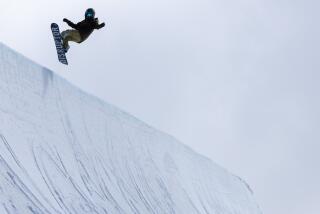Avoiding the Wheels of Misfortune
- Share via
When this year’s rainy season finally ends, Southern California mountain bikers will be out in force, headed for favorite trails.
More than 11 million Americans ride mountain bikes, the sturdy fat-tired cycles designed to withstand trails and rough roads.
Mountain biking gets a thumbs-up from exercise experts. It’s thought to be one of the best cardiovascular conditioning workouts around. The activity also tones and strengthens the muscles of the thighs, hips and buttocks.
Despite these benefits, mountain biking has a reputation as a sport with a high injury rate. But experts say mountain bikers can do much to reduce the risk of injury by getting into shape (or better shape) before riding.
Bicylists in reasonably good condition who exercise three times a week should give themselves about six weeks to focus on specific exercises to prepare for mountain biking, said Rudy Hayek, exercise physiologist and director of Sierra Health & Fitness, a workout facility in Sierra Madre. Those who are sedentary, overweight or both should give themselves about three months to get into shape, he said.
Besides regular cardiovascular conditioning, Hayek advises scheduling some resistance training, such as biceps curls and push-ups. Upper-body strength is crucial when climbing hills, since the arms and upper back are used to support the body when it is shifted off the seat for extra pumping power. Pay attention to abdominal work too by doing crunches and other abdomen-strengthening exercises. A strong midsection helps mountain bikers maintain control, minimizing the chance of spills.
It is important to warm up for at least five or 10 minutes by pedaling in low gear over flat terrain until you break a sweat, according to experts at the American Council on Exercise, a San Diego organization that certifies fitness instructors and educates the public about the value of exercise.
Those new to mountain biking should also get a feel for how the brakes work. The front brake on a mountain bike usually has more power than the back, according to ACE’s experts, and pulling it alone may send you flying over the handlebars. For that reason, experts advise practicing quick stops before hitting the trail so the rider becomes accustomed to how his or her weight affects stopping. Riders should also learn a technique called feathering--lightly squeezing and releasing the brakes when descending a hill--so the wheels don’t lock, experts advise.
In addition to having a sturdy bike and mastering basic techniques, riders should wear a good helmet, said Diane C. Thompson, an epidemiologist at the Harborview Injury Prevention and Research Center at the University of Washington, Seattle. She and Dr. Frederick Rivara, the center’s director, studied cycling injuries and published their findings last year in the Journal of Family Practice.
“Get a helmet with good coverage,” Thompson advised. Look for one that has earned the approval of the Snell Memorial Foundation, ANSI (American National Standards Institute) or ASTM (American Society for Testing and Materials). The helmet will have a seal stating such approval.
Thompson said a mountain bike helmet should extend down the back of the head as far as possible and cover some of the forehead. She recommends that riders pass up the sleeker, smaller racing-style helmet because it doesn’t provide as much coverage. Also recommended are knee and elbow pads to minimize injury from falling.
In their study, the Seattle researchers evaluated 3,390 cyclists who had been injured. “While rates of injuries appear to be high in off-road cycling, the majority of these injuries appear to be relatively minor,” the journal report said. Off-road cyclists are less likely to suffer head and face injuries than other riders, mainly because off-road cyclists are more likely to wear helmets.
The Seattle researchers also developed a profile of a typical injured off-road cyclist: a male 20 to 39 years old who didn’t ride every day. Hitting obstacles on the trail was the most likely cause of crashes for all cyclists. Upper-extremity injuries were most common for mountain bikers, followed by lower-extremity injuries, abdominal or chest injuries, facial injuries and head injuries. Least common were neck injuries.
*
The Healthy Traveler appears the second and fourth week of every month.
More to Read
Sign up for The Wild
We’ll help you find the best places to hike, bike and run, as well as the perfect silent spots for meditation and yoga.
You may occasionally receive promotional content from the Los Angeles Times.






